Warning: include(/usr/local/psa/home/vhosts/vvs.hobbyvista.com/httpdocs/top.php): failed to open stream: No such file or directory in /home/hobbyvis/public_html/vvs.hobbyvista.com/Modeling/Polikarpov/I-153/72nd_Comparison/index.php on line 15
Warning: include(): Failed opening '/usr/local/psa/home/vhosts/vvs.hobbyvista.com/httpdocs/top.php' for inclusion (include_path='.:/usr/lib/php:/usr/local/lib/php') in /home/hobbyvis/public_html/vvs.hobbyvista.com/Modeling/Polikarpov/I-153/72nd_Comparison/index.php on line 15
To Build, or Not to Build --Is That
The Question?
Notes on the I-153 in Plastic in 1:72
Scale
It occurs to me that many of us who model in 1:72
have always been somewhat jealous of the fine kits offered in 1:48 for a number
of VVS aircraft. Certainly there is no equivalent in 1:72 for the Eduard Yak-3,
for example. The most obvious--and in many ways the most glaring--demonstration
of this shortcoming is with regards to the Polikarpov I-153 biplane. A classic
aircraft, much known and beloved by modelers around the world, and there is simply
nothing suitable to make such a model in 1:72 scale. This is all the more galling
when the 1:48 scale crowd have a pretty good (and, to be fair, for the time of
its release quite accurate) kit from Classic Airframes. Grrr...
Well, what to do? Can you make an accurate
I-153 with the existing 1:72 resources? Let us have a look at that question.
And, as well, we'll explore some other I-153 matters in the process....
The Kits
There are essentially two I-153 molds in 1:72
today. Indeed, these have traveled under many names, and have been released
under more labels than perhaps we even know. The basic molds are from Heller,
which date (I recall) to the 1980s, and from A-Model, which was based
on the Heller to some extent, and which dates from the 1990s.
Heller
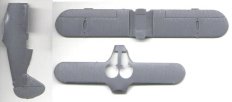 The
original Heller mold has been released by no fewer than 3 companies to date,
including SMER, AER (with modifications), etc. Judging by this kit, one sees
no evidence that there is in fact an actual I-153 (admittedly, of dubious detail
and pedigree, but nonetheless at least partly genuine) in the collection of
the Musee de l'Air in Paris. That Heller is a French company is all the
more perplexing. How can this be so, and from whence did this kit's outline
and details devolve?
The
original Heller mold has been released by no fewer than 3 companies to date,
including SMER, AER (with modifications), etc. Judging by this kit, one sees
no evidence that there is in fact an actual I-153 (admittedly, of dubious detail
and pedigree, but nonetheless at least partly genuine) in the collection of
the Musee de l'Air in Paris. That Heller is a French company is all the
more perplexing. How can this be so, and from whence did this kit's outline
and details devolve?
The latter question can be answered definitively,
at least. The Heller kit is clearly based upon drawings which eventually appeared
in Miranda and Mercado's book on aviation in the Spanish Civil War [Aviacion
Mundial en Espana Guerra Civil 1936-39 ]. The appearance and detail of the
Heller mold is largely a replica of the line drawings offered in this volume.
At the time these drawings were completed they must have seemed to be the best
available in the Western world. Perhaps they were (though, recall that modeling
magazines from Eastern Europe were available at the time, and with better drawings),
but this does not at all explain why any set of drawings would have been used
in lieu of an examination of an actual specimen. In one's own national air museum,
no less.
Furthermore, even the most cursory glance at
the Musee's example shows that the drawings are quite inaccurate. Beyond
the fact that the drawings in Miranda and Mercado's book (quite intriguingly)
show an early manufacture M-62 aircraft of the 1939 period, it is blatantly
obvious that the wing/fuselage shape and details are simply not related to the
actual I-153's in any manner. It is hard to believe that any master maker for
the Heller mold could have missed such a glaring problem. Is it possible that
the master maker looked at the Musee example at all? It seems that some
examination of the Musee example must have been undertaken, because the
model differs in respect to the Aviacion drawings with respect to the
over-all dimensions of the aircraft, and this would seem to indicate that at
least fundamental measurements were taken of the actual machine. More than that,
however, one is not inclined to accept that a thorough examination of the airframe
was made.
Amodel
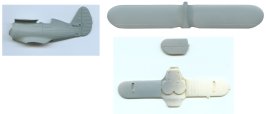 It
seems to me that Amodel certainly based their I-153 kit on the Heller mold to
some extent. The similarity in many regards (the wing and sprue arrangement,
especially) to that kit are too strong to explain in any other way. Alas. However,
A-Model must have had access to improved I-153 drawings. I would suspect most
likely, here, those from the 1982 series (I forget the issue) of MK magazine.
Basically, the fuselage detail in those drawings was poor, and the wing detail
was ok, but perhaps not great.
It
seems to me that Amodel certainly based their I-153 kit on the Heller mold to
some extent. The similarity in many regards (the wing and sprue arrangement,
especially) to that kit are too strong to explain in any other way. Alas. However,
A-Model must have had access to improved I-153 drawings. I would suspect most
likely, here, those from the 1982 series (I forget the issue) of MK magazine.
Basically, the fuselage detail in those drawings was poor, and the wing detail
was ok, but perhaps not great.
This situation is mirrored in the A-Model kit.
The fuselage has been reworked slightly from the Heller mold. It is not, unfortunately,
any nearer to the realms of accuracy, however. The detail here is partly recessed,
and rather nice as a matter of fact. The wings are certainly reworked Heller
units. The absurd ribbing detail of the Heller unit's centre-section is gone,
and some attempt has been made to improve the detail on the wing surface. However,
the shape and planform is largely unchanged, and therefore equally erroneous.
The same is true of the stabilizers, and so forth.
Was it the case that A-Model chose not to re-engineer
the kit? The attempts to modify several features shows that A-model must have
known that there were serious problems. Was it too expensive, perhaps? We will
probably never know....
AER
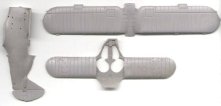 Essentially,
this mold seems to be an adaptation of the Heller effort. Alas, many of the
kit details have been replicated with very poor raised detail work. This type
of "detail" is pretty poor, and in most cases fails to line up on the model.
Essentially,
this mold seems to be an adaptation of the Heller effort. Alas, many of the
kit details have been replicated with very poor raised detail work. This type
of "detail" is pretty poor, and in most cases fails to line up on the model.
SMER
Another issue of the Heller mold.
Detailed Parts Analysis
Before deciding how, or whether,
to proceed, let's look at the kits' parts in some detail. For reference, we
will compare them to drawings based upon Mikhail Maslov's superlative work in
his title "I-153" (from Teknika Molodezhi Pubs.) [Ed
Note: as well, in a few months modelers will be able to examine the outstanding
drawings in my own book for reference]. Once again,
the brilliant historian Maslov has provided ground-breaking research and analysis
of the Polikarpov OKB's designs, here with regards to the wonderful Chaika.
Fuselage
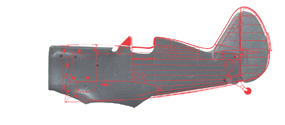 Heller
Heller
The Heller mold's fuselage is closest in terms
of overall length, at least in regards to the rear fuselage. However, the entire
unit has been pinched flat in the vertical axis, while the forward fuselage
has been grossly stretched out. The lower wing fillet is absurd, and anemic.
A-Model
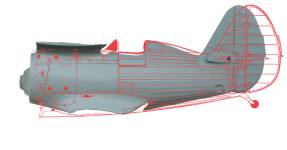 Further
comment is probably not required. I cannot see how this model's fuselage can
claim to depict the I-153 fighter. That may sound harsh, but with access to
excellent written material, in addition to drawings from not only MK magazine,
but also KP, KR, and IA model magazines, as well as from
Shavrov's books, how could A-Model fail to get right at least the fundamental
measurements? To the degree of one fifth the length of the entire fuselage!
I am at a loss....
Further
comment is probably not required. I cannot see how this model's fuselage can
claim to depict the I-153 fighter. That may sound harsh, but with access to
excellent written material, in addition to drawings from not only MK magazine,
but also KP, KR, and IA model magazines, as well as from
Shavrov's books, how could A-Model fail to get right at least the fundamental
measurements? To the degree of one fifth the length of the entire fuselage!
I am at a loss....
Wings
Heller/AER
 The
image here is actually of the AER wing, but it mirrors the shape and size of
the Heller unit entirely (see the parts scan above). In addition to being severely
distorted and asymmetrical, the Heller mold presents a wing centre-section that
defies all logic. This completely ludicrous ribbing detail is certainly from
the Aviacion drawings, and indeed the entire central portion of the wing
is appalling. The hugely oversized aileron trim tabs are a curiosity, as well.
The unit also lacks all form of dihedral, seen from the frontal aspect. In short,
the wing is atrocious.
The
image here is actually of the AER wing, but it mirrors the shape and size of
the Heller unit entirely (see the parts scan above). In addition to being severely
distorted and asymmetrical, the Heller mold presents a wing centre-section that
defies all logic. This completely ludicrous ribbing detail is certainly from
the Aviacion drawings, and indeed the entire central portion of the wing
is appalling. The hugely oversized aileron trim tabs are a curiosity, as well.
The unit also lacks all form of dihedral, seen from the frontal aspect. In short,
the wing is atrocious.
A-Model
 In
the area of the wings A-Model certainly has done slightly better. There still
is an enormous gap between the kit's wing and the actual appearance, but at
least the ridiculous ribs are no longer present, and some attempt has been made
to clean up the wing surface detail. Again, there is no attempt to provide for
proper dihedral, and the span is a bit short, as can be seen.
In
the area of the wings A-Model certainly has done slightly better. There still
is an enormous gap between the kit's wing and the actual appearance, but at
least the ridiculous ribs are no longer present, and some attempt has been made
to clean up the wing surface detail. Again, there is no attempt to provide for
proper dihedral, and the span is a bit short, as can be seen.
Lower Wings
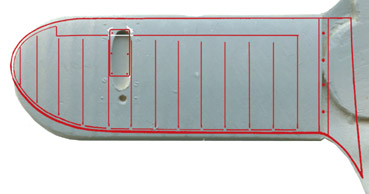 All of the I-153 kits employ the same lower wings, so this one
image (in fact from the A-Model kit) will suffice. The unit is bloated in the
vertical axis, while too stubby longitudinally. The wing shape is quite inaccurate,
whilst details like the strut panel, and so forth, are equally poor. Once again,
dreadful.
All of the I-153 kits employ the same lower wings, so this one
image (in fact from the A-Model kit) will suffice. The unit is bloated in the
vertical axis, while too stubby longitudinally. The wing shape is quite inaccurate,
whilst details like the strut panel, and so forth, are equally poor. Once again,
dreadful.
Stabilizers
Heller/AER/A-Model
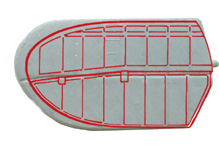 All of the I-153 kits employ the same stabilizers, so this one
image (also from the A-Model kit) will suffice. The shape is entirely wrong,
and based upon the Aviacion drawings. The graphic here speaks for itself.
All of the I-153 kits employ the same stabilizers, so this one
image (also from the A-Model kit) will suffice. The shape is entirely wrong,
and based upon the Aviacion drawings. The graphic here speaks for itself.
Cowling
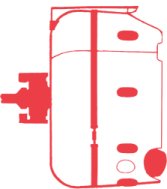
It proved too difficult to scan in an image of the cowling that
could be used for a scale drawing comparison, alas. This line drawings shows
the correct appearance of the M-62 engined unit. Even a cursory glance at all
of the I-153 kits shows that none of the cowling units resembles this drawing.
The A-Model cowl is perhaps closest, but still rather far from the shape and
detail that one would like to see.
Various Parts
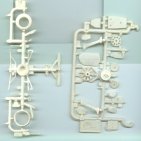
The breakdown of the remaining sundry parts on all of these kits
is again nearly identical (another A-Model image, here). None of them are particularly
noteworthy. The main interplane struts are poor, as are the braces for the stabilizers.
The engine is rudimentary, but as this really cannot be seen, it would matter
little. The cowling face plate is poor, and does not represent the actual item
at all. The cockpit detail is, well, exceedingly basic. And, so on.
Good Heavens, Now What!?
Well, an excellent question. Alas, I cannot offer a suitably
outstanding answer. My impression, speaking as a medium ability modeler, is
that I cannot personally see how to proceed with any of these kits. A master
class modeler might attempt to perform a very serious 'kit-bash'. Using essentially
the best bits of the two molds, one might try to graft the rear Heller fuselage
onto the A-Model front fuselage, just at the cockpit. The A-Model upper wing
would be used, and would have to have the tips suitably lengthened. The lower
wing would have to be re-shaped, probably again best using the A-Model unit.
The same is true for the stabilizers. The entire model would have to be rescribed,
by all means. All sundry details like struts and such would have to be scratch-built.
Lastly, the cowling would probably have to be scratch-built, or possibly based
upon the A-Model unit with much re-working.
I would say that the opportunity surely exists for a new and
correct I-153 kit in 1:72. This is a critical aircraft in regards to VVS modeling,
and the beloved Chaika served in various other countries, as well. That
there is simply no reasonable way to make a model of this aircraft in 1:72 scale
is a disappointment, to say the least....
 The
original Heller mold has been released by no fewer than 3 companies to date,
including SMER, AER (with modifications), etc. Judging by this kit, one sees
no evidence that there is in fact an actual I-153 (admittedly, of dubious detail
and pedigree, but nonetheless at least partly genuine) in the collection of
the Musee de l'Air in Paris. That Heller is a French company is all the
more perplexing. How can this be so, and from whence did this kit's outline
and details devolve?
The
original Heller mold has been released by no fewer than 3 companies to date,
including SMER, AER (with modifications), etc. Judging by this kit, one sees
no evidence that there is in fact an actual I-153 (admittedly, of dubious detail
and pedigree, but nonetheless at least partly genuine) in the collection of
the Musee de l'Air in Paris. That Heller is a French company is all the
more perplexing. How can this be so, and from whence did this kit's outline
and details devolve?



 Further
comment is probably not required. I cannot see how this model's fuselage can
claim to depict the I-153 fighter. That may sound harsh, but with access to
excellent written material, in addition to drawings from not only MK magazine,
but also KP, KR, and IA model magazines, as well as from
Shavrov's books, how could A-Model fail to get right at least the fundamental
measurements? To the degree of one fifth the length of the entire fuselage!
I am at a loss....
Further
comment is probably not required. I cannot see how this model's fuselage can
claim to depict the I-153 fighter. That may sound harsh, but with access to
excellent written material, in addition to drawings from not only MK magazine,
but also KP, KR, and IA model magazines, as well as from
Shavrov's books, how could A-Model fail to get right at least the fundamental
measurements? To the degree of one fifth the length of the entire fuselage!
I am at a loss.... 


